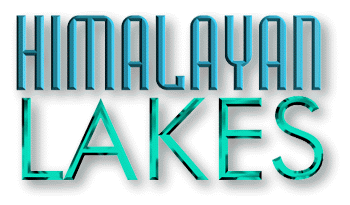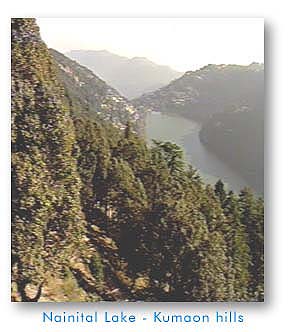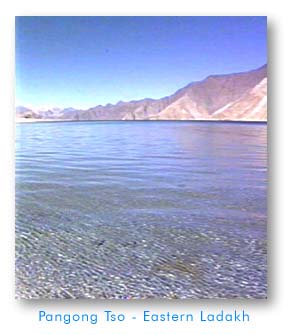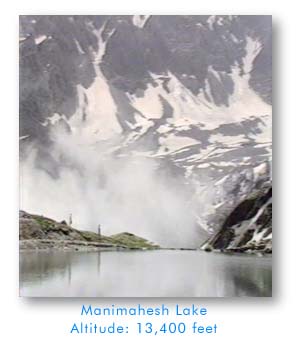Karamjeet Singh's Himalayan Home

 To most city dwellers, the word "lake" conjures up a vision of placid waters, boats with
semi-recumbent revelers and other paraphernalia of a tourist resort, all backed by an
equally placid, non threatening scenic background. The Dal lake, the Naini lake and
others like the Renuka lake near Nahan....
To most city dwellers, the word "lake" conjures up a vision of placid waters, boats with
semi-recumbent revelers and other paraphernalia of a tourist resort, all backed by an
equally placid, non threatening scenic background. The Dal lake, the Naini lake and
others like the Renuka lake near Nahan....
All these lakes are found between the three and seven thousand foot levels.
Lakes of the middle and lower altitudes, as in Kumaon, have suffered the effects of
environmental degradation for decades now. Lakes such as Nainital, Bhimtal etc. because
of their accessible location, have become classic examples of the total degradation of God
given resources by human callousness.
Reduced oxygen content, high levels of nitrogen and phosphorous, make the
water unsafe for human contact and are rapidly depleting the lake's carp population, an
interloper itself.
Beyond the common perception, lie the true Great Himalayan lakes, most
occurring in the trans. Himalayan regions, where the lie of the land is easier.
The great lakes of Ladakh ...Tso Morari and Pangong Tso - almost like inland seas, the  highest of them all- Gurudogmar in north Sikkim at an altitude of 17,600 feet above sea
level. and The jewel like Chandratal in Lahaul
highest of them all- Gurudogmar in north Sikkim at an altitude of 17,600 feet above sea
level. and The jewel like Chandratal in Lahaul
One of the most classically beautiful of all Himalayan lakes is the Chandratal in
Lahaul's upper Chandra valley. Aptly called the lake of the moon, it lies in a broad
turquoise crescent along the flank of the Great Himalaya range itself, surrounded by the
high peaks of the Chandrabhaga and the Mulkila massifs.
Situated at a breathtaking 15500 feet above sea level, the lake itself was
probably formed at the end of the last ice age when the glaciers retreated, leaving behind
considerable dead ice masses, which on melting formed large lakes.
Other Transhimalayan lakes like the Pangong and TsoMorari saw similar
beginnings. Most of these lakes had no outlet. The huge amounts of water present at the
outset evaporated very fast in the desert like atmosphere and what had been initially
freshwater became brackish and finally salty.
The greatest lake in the Indian Himalayas is undoubtedly the Pangong Tso. At an altitude
of almost 4500 meters, the Pangong Tso, across the Changla pass, from Leh is only 8 km
wide at it's broadest but is an amazing 134 kilometers long bisected by the international  border between India and Tibet. Most of the fresh water inlets into the lake are towards the
Tibetan end.
border between India and Tibet. Most of the fresh water inlets into the lake are towards the
Tibetan end.
Pangong Tso, bathed in the varying light of the day, is a memorable sight. The golden
coloured range to the north, with it's rolling spurs culminating in chiseled peaks spreads
before your eyes a panorama of spectacular dimensions. With it's almost 2000 square
kilometers of turquoise water and a depth of a 100 meters, Pangong can baffle the eye, for
in the rarefied atmosphere distant objects appear right next door.

On the windward side of the great range, lakes occur at all altitudes up to 17,000 feet,
getting progressively smaller the higher they go. In fact, in the higher reaches they are
often morainic pools styled as lakes because they are pilgrim destinations. Manimahesh
lake in Upper Chamba is one such destination overlooked by the lone pyramid of Kailash
manumahesh itself. Such lakes draw their waters from the melting of glacial ice.
 Suraj Tal at the famed Baralacha pass draws it's waters from the snowmelt on the
surrounding ridges. Geologically, Surajtal occupies a glacial depression, probably ground
down by the ice during the last Himalayan Ice age.
Suraj Tal at the famed Baralacha pass draws it's waters from the snowmelt on the
surrounding ridges. Geologically, Surajtal occupies a glacial depression, probably ground
down by the ice during the last Himalayan Ice age.
Then there are what can be termed mountain tarns - small lakes in the higher
altitudes formed by the glacial activity of the remote past. These are mostly on the crest of
the Pir-Panjal range and extend all the way across to the Upper Beas.


This page hosted by
 Get your own Free Home Page
Get your own Free Home Page
Web Page Design and Images Copyrightę: Karamjeet Singh


 To most city dwellers, the word "lake" conjures up a vision of placid waters, boats with
semi-recumbent revelers and other paraphernalia of a tourist resort, all backed by an
equally placid, non threatening scenic background. The Dal lake, the Naini lake and
others like the Renuka lake near Nahan....
To most city dwellers, the word "lake" conjures up a vision of placid waters, boats with
semi-recumbent revelers and other paraphernalia of a tourist resort, all backed by an
equally placid, non threatening scenic background. The Dal lake, the Naini lake and
others like the Renuka lake near Nahan.... highest of them all- Gurudogmar in north Sikkim at an altitude of 17,600 feet above sea
level. and The jewel like Chandratal in Lahaul
highest of them all- Gurudogmar in north Sikkim at an altitude of 17,600 feet above sea
level. and The jewel like Chandratal in Lahaul border between India and Tibet. Most of the fresh water inlets into the lake are towards the
Tibetan end.
border between India and Tibet. Most of the fresh water inlets into the lake are towards the
Tibetan end.

 Suraj Tal at the famed Baralacha pass draws it's waters from the snowmelt on the
surrounding ridges. Geologically, Surajtal occupies a glacial depression, probably ground
down by the ice during the last Himalayan Ice age.
Suraj Tal at the famed Baralacha pass draws it's waters from the snowmelt on the
surrounding ridges. Geologically, Surajtal occupies a glacial depression, probably ground
down by the ice during the last Himalayan Ice age.

